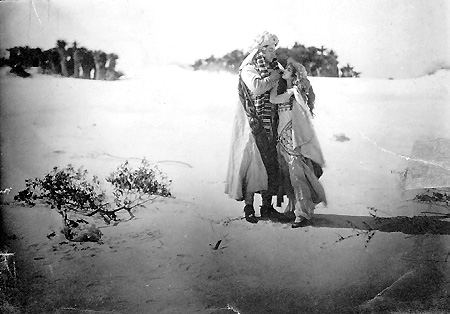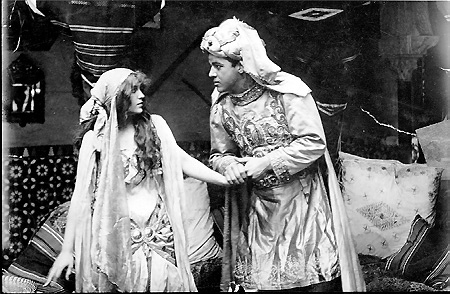 Volume II: Filmography
Volume II: Filmography Volume II: Filmography
Volume II: Filmography


Production stills from St. Augustine, Florida. Courtesy of the Academy of Motion Picture Arts and Sciences. (F-490-1 & F-490-2)
March 1, 1912 (Friday)
Length: 1 reel
Character: Drama
Director: George O. Nichols
Cameraman: A.H. Moses, Jr.
Cast: James Cruze (the wealthy Moor), Florence LaBadie (the rich Moor's daughter), William Russell (the young Arab sheik [rug weaver in some reviews]), Joseph Graybill (buyer of the daughter), (Note: Some sources transpose the roles of Cruze and Russell)
Location: Filmed on the beach at St. Augustine, Florida by Thanhouser's Southern Company, and billed as "the first Florida feature."
ARTICLE, The Moving Picture World, February 24, 1912:
"The Thanhouser factory at New Rochelle is working overtime on the first Florida negative to be issued, The Arab's Bride, releasing Friday, March 1. Some 'peachy' photographic effects are reported by the darkroom men and it is patent that the New Rochelle firm is ushering in its Florida subjects with a strong opening attraction. New Rochelle, of course, says that all the Florida pictures will be up to the standard of this first one...."
SYNOPSIS, The Moving Picture World, February 24, 1912:
"A wealthy Moor had one treasure he failed to prize at its real value, his beautiful daughter. To him she was simply a woman, a source of expense while a child, and a treasure only if a rich suitor came along to whom she could practically be sold. In course of time the rich man did appear, and was enthusiastically greeted by the father. The daughter, however, had the temerity to say that she did not love the man. In fact her heart had been won by another, a young Arab sheik she had seen while in the market place. She knew little about him, but was convinced that he was far more worthy than the suitor her father had selected. The father was obdurate, however. He did not deign to argue with the girl, and simply commanded her to prepare for the ceremony, and with sighs and tears she did so. The girl had a faithful attendant, homely, but quick-witted and resourceful. The attendant proposed a plan which she thought had merit, for it could make three persons happy. And affairs came out as she had predicted. The father was happy because he got the money that had been promised him, the daughter and the sheik were pleased because they married, and the attendant was satisfied, for she won a rich husband, although having neither cash nor beauty. The only unhappy person was the rich suitor, but then he was wealthy, and riches bring their own consolation."
REVIEW, The Morning Telegraph, March 3, 1912:
"The Thanhouser Company selected one of the most difficult feats in stage production when endeavoring to present Orientalism and Oriental types in this photoplay, combined with a serious drama. The result is pleasing, and it is with difficulty that a writer can find words to express proper appreciation of the photographic effects and the scenical results. The view of the city in the distance, evidently an effect in double printing or double exposure, is well worthy of praise. The interiors, the house exteriors, the properties and the costuming all call for favorable comment while the acting is a continuous series of excellent portrayals of a difficult line of parts. The story, simple, direct and forceful, tells how a rug weaver wins a girl from an Oriental nobleman and elopes with her to his desert home."
Note: This review incorrectly places Arabia in the Orient.
REVIEW, The Moving Picture World, March 9, 1912:
"The backgrounds of this clever picture very strongly suggest Arabian desert lands near some Baghdad or a fabled city in the East. The action shows how the master rug weaver (Mr. Russell) fell in love with the vizier's daughter (Miss LaBadie) who bought the rug, 'work of his hands.' In his carrying her away there is true old-time romance. Many of this picture's scenes are extremely beautiful. It is a sure feature for almost any occasion."
REVIEW, The New York Dramatic Mirror, March 6, 1912:
"The atmosphere of the East is admirably conveyed in this picture, both by backgrounds and action. Altogether it is an excellent example of Thanhouser versatility. The story also has elements of great dramatic strength. The Arab having woven a rug takes it to the city to sell. The daughter of a person of consequence, out shopping in true Oriental fashion, sees the Arab and the rug and buys the latter. He follows to her home and they have a secret meeting managed with all the romantic detail we have learned from the Arabian Nights to expect in such affairs. But the girl's father sells her to the potentate and she is about to be delivered, when our Arab appears and gallantly fights his way until he rescues her and bears her off to his desert home. The picture is a model of its kind. Flo LaBadie played the bride with excellent romantic fervor, and William Russell was a commanding Arab. James Cruze was the father and Joseph Graybill the buyer of the girl."
# # #
Copyright © 1995 Q. David Bowers. All Rights Reserved.